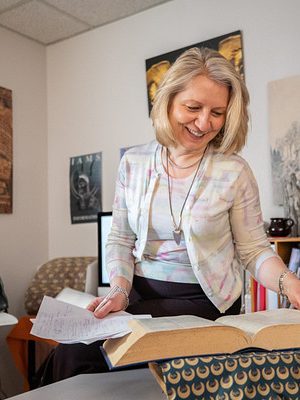 Congratulations to Dr. Zsuzsanna Gulácsi, Professor of Art History and Asian Studies, on her recent invited lecture at the tenth meeting of the International Association of Manichaean Studies in Aarhus in August 2022. The Carlsberg Research Foundation at the University of Aarhus, Aarhus (Denmark) sponsored the conference.
Congratulations to Dr. Zsuzsanna Gulácsi, Professor of Art History and Asian Studies, on her recent invited lecture at the tenth meeting of the International Association of Manichaean Studies in Aarhus in August 2022. The Carlsberg Research Foundation at the University of Aarhus, Aarhus (Denmark) sponsored the conference.
Abstract: The Manichaean Prayer and Confession Book in the collection of the Asian Art Museum, Berlin (III 53)—also known as the BBB (M801a) after W. B. Henning’s pioneering study from 1937, “Ein manichäisches Bet- und Beichtbuch”—is the most intact Manichaean book found in the Turfan region and the only one preserved bound as a codex. The surviving 48 pages originally constituted part of a liturgical book, produced in the form of an exquisite miniature (9.2 cm in height) paper codex during the Uygur era of Manichaean history (762-1124 CE). Yet, its content belongs to the earliest Manichaean literature. It includes an excerpt of Mani’s Seal Letter in Middle Persian, numerous hymns in Parthian and Middle Persian, and a set of formulaic confessions of the elect in Sogdian. These texts contain the words recited during the most important liturgy of the Manichaean Church—the annual Bema Ceremony—that commemorated Mani’s death and expressed hope for the ultimate salvation of his followers. This study centers on the codicology of the BBB based on my contribution to its new translation by Nicholas Sims-Williams, inaugurating the Series Iranica of the Corpus Fontium Manichaeorum (Brepols 2022). It argues that the BBB is essential for understanding the overall codicology of the Turfan manuscript fragments, and also how these manuscript fragments came to be preserved in the disjointed and incomplete forms, not in libraries, but in genizah-like repositories of sacred waste, where they were laid to rest in manistans across Uygur Central Asia.
